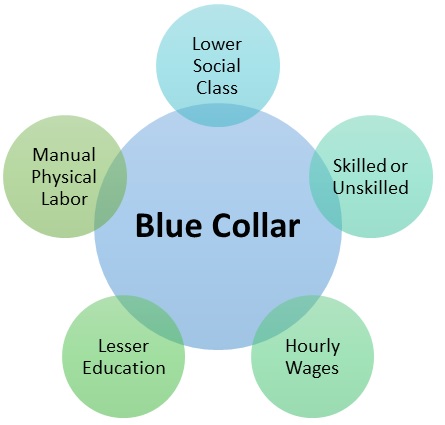- Business Concepts ›
- Human Resources (HR) ›
- Blue Collar Employees
Blue Collar Employees
Definition, Importance, Types & Example
This article covers meaning & overview of Blue Collar Employees from HRM perspective.
What is meant by Blue Collar Employees?
Blue collar refers to the working class who performs manual labor requiring jobs, which may require skilled or unskilled work of physical nature. Blue Collar employees are primarily workers who are engaged in manual labor. They are mainly involved in manufacturing, processing, construction, warehousing, maintenance and other types of physical work. Some of the blue collar work is skilled while other work is unskilled in nature and is usually not performed in an office environment. The type of work for a blue collared worker is mainly related to something being manufactured, physically built or maintained. The term "blue collar" is one of the types of occupations, others being “white collar” and “Pink collar”.
The job may be of various kind ranging from manufacturing, mining, construction, mechanical, maintenance, technical installation or any other job of similar sort. Some blue-collar occupations require highly skilled personnel, preferably who have some sort of training and certification. Other jobs may have no such requirement. Often something is physically being built or maintained. Payment of wages for blue collar workers is mostly set at hourly rates or daily rates, but some skilled professionals are paid at the completion of a project or monthly wages. Most of the Blue collar employees are required to wear uniforms that are durable in nature. The uniforms are mostly blue in color because grease stains are not very visible on blue cloth and the cloth appears to be cleaner.
In contrast to this type of job, people who perform professional jobs are said to be doing a “white collar” job. The origin of this term comes from the fact that white collar employees typically worked in office settings and wore white, button down shirts. Another employee classification is known as pink collar employees.

Importance of Blue Collar Employees
The term “blue collar” came into use because historically people performing manual labor wore usually blue colored uniforms since it could hide a little dirt around the collar, and hence suited for manual work. The pay scale for the labor work has a wide range and depends upon field of specialty and experience. Many workers are often paid hourly, although some professionals may be paid on the project basis or may be salaried. Blue collar workers are an integral part of the workforce in an organization where industrial processes like manufacturing, warehousing, construction, maintenance or processing is taking place they directly influence the revenue of the organization and therefore it is important to keep them motivated so that they have a higher productivity.
Technology has emerged as a real threat for blue collar workers in jobs which involve less decision making or is repetitive in nature.
Self driving cars have emerged as a major threat for truck drivers, in the same way automated cleaning services have been decreasing the demand for sanitation workers.
Blue Collar Job Types
Some of the most popular and top blue collar jobs are:
1. Construction workers & inspectors
2. Plumbers
3. Iron and steel employees
4. Electrical fitting workers
5. Aviation mechanics
6. Lift Mechanics
7. Cops
8. Train & Metro Motormen
9. Industrial Equipment repairers
10. Janitors & Cleanliness staff
Difference Between White Blue & Pink Collar Employees
Educational requirements for a blue collar worker are lower than that for a white collar worker. Typically a high school is sufficient for blue collar workers; Blue collar workers learn many of the skills required on the job, which is not the case with white collar workers. White collar workers are typically workers in managerial or administrative roles.
Pink Collar workers are workers usually found in the service industry like nurses, salespersons, waiters etc. Traditionally pink collar jobs were dominated by women but now are filled by men as well these job pay significantly less as compared to white collar and blue collar jobs.
Example of Blue Collar Workers
Blue Collar employees are the workers mainly engaged in physical labor they are an integral part of industries related to manufacturing of goods, commercial fishing, maintenance, warehousing and technical installation. Some examples of blue collar employees are:
1. Electrician
2. Plumber
3. Janitor
4. Welder
The educational requirements for a blue collar worker is less than that for a white collar worker, unskilled and repetitive tasks are being automated and these jobs are being lost.
Hence, this concludes the definition of Blue Collar Employees along with its overview.
This article has been researched & authored by the Business Concepts Team which comprises of MBA students, management professionals, and industry experts. It has been reviewed & published by the MBA Skool Team. The content on MBA Skool has been created for educational & academic purpose only.
Browse the definition and meaning of more similar terms. The Management Dictionary covers over 1800 business concepts from 5 categories.
Continue Reading:
What is MBA Skool?About Us
MBA Skool is a Knowledge Resource for Management Students, Aspirants & Professionals.
Business Courses
Quizzes & Skills
Quizzes test your expertise in business and Skill tests evaluate your management traits
Related Content
All Business Sections
Write for Us